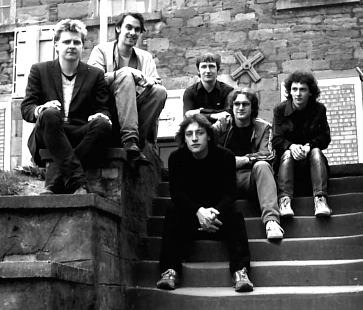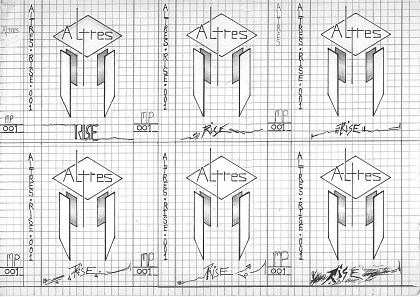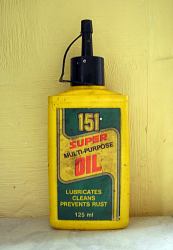ALTRES
Rise (MP001) - originally released in 1984
![[ALTRES - Rise]](risecolour.jpg)
Download no longer available.
After the successful Tayside Bar gig, we began meeting regularly to continue playing and recording music. The venue for these sessions was Brian's house, much to the alarm of his mum, gran and Kara the dog.

Altres sit on some steps, circa 1984
From left - Jeremy, Mike, Brian, Kevin, Maurice & Joe
Over the months our line-up expanded to a six-piece with the addition of Jeremy Bryning on synths and Mike Nelson on guitar.
Most of our compositions would begin with a sequence or sound which we would play around with for a bit before hitting the record button, or sometimes we would just start recording straight away. Almost all of the pieces on "Rise" and our other cassettes were composed and recorded this way. Often first takes were used and sometimes the track would be recorded once then never played again.
Recording methods were very basic. Most of the time all of the instruments were fed through various effects and echo units, then into mini-mixers before being recorded on a cassette deck. Everything was played and recorded "live" - there were no overdubs.
After a few months we had a lot of material on tape, so we decided to release our first cassette. Any other format, ie vinyl, was out of the question - we were still financially challenged and no-one was rushing to offer us a recording contract. Also, CDs hadn't been invented yet.
Equipment
Our musical equipment had improved slightly.
- Jeremy: Tiesco S60F, Casio MT40, various self-built effects.
- Joe: Moog Prodigy
- Kevin: EDP Wasp, Roland SH-101, Casio VL-Tone, Soundmaster Stix drum-machine
- Brian: Korg MS20, MS50, SQ10 & vocoder
- Mike: Ibanez guitar, various effects
- Maurice: Korg Poly-61
Track Details
We finally settled on the following track listing:
1. Rise
This was based on a sequence and drum pattern Kevin had been messing about with. The transpositions were suggested by Joe and it was a second take recording.
Mike: "At the time of the 'Rise' cassette Kevin and myself were staying in the same student flat. I distinctly remember hearing the 'Rise' sequence for the first time while passing Kevin's room, where he was sitting balefully staring at the SH-101 looking like he had been doing this for some time. I said, 'that sounds good' and we tried out some transpositions. I, however, never knew how the actual transpositions used and the trademark 'na-na-na-na-na' came about."
Everything was plugged directly into the tape recorder, so we were able to shout things to each other while we were playing, like "Let's have a quiet bit here" and "everyone come back in on the count of 4". We almost all made it on time.
Mike: "I know it's a pretty poor excuse for not coming back in on time after the quiet section, but I had in fact dropped my guitar on the floor to create a 'bong' sound. I, therefore, had to pick the guitar up during the count in."
The sequence was inspired by the piano theme from Lucio Fulci's film "The Beyond", but ended up sounding nothing like it.
Someone once said to us that this track reminded them of a seagull swooping majestically over the Scottish mountains. Or perhaps they said "eagle"...
2. Golden Country
There is some disagreement about who came up with the sequence for "Golden Country".
Brian: "Golden Country was developed from a ten-note sequence I'd been working away at on the Korg MS20 controlled by the Korg SQ10. I had used one of the channels on the SQ10 to trigger the VCF and achieved a level of instant control over the brittleness and sparkle of individual notes. This was then stuck through a tape echo unit.
"My memories of recording this are fuzzy to say the least but I remember the key change towards the end was instant; Jeremy just shouted 'up a tone' and we all followed. Joe provided the melody lines I think and Maurice the big chords towards the end."
Joe: "Hmm... I seem to think that I came up with the sequences for Golden Country - it is a ten note sequence with a doubled five note bass underneath so it used two channels on the SQ10. I played the main theme with Jerm doing a nice counterpoint. This track featured one of our first attempts at a chord change - see if you can spot it! We used the sequencer to trigger Maurice's polysynth for the arpeggio section and Maurice added what were to become his trademark big chords at the end. I got a bit carried away with the pitch bend at one point and I'm afraid I strayed beyond the limits of good taste!
"The title came from George Orwell's '1984' oddly enough. It refers to a Utopian land that the main character Winston Smith dreams of. The alternative of Golden Rain was rejected!"
Kevin: "Well, it wasn'ae me!"
Mike: "Or me."
3. Sometimes Elsewhere
This is based around a guitar part played by Mike tapping on the frets.
Mike: "This was an offshoot of what Les called my 'Mekon Head Sound', in which I would drum on the frets with one hand and twiddle the knobs on my amp with the other (mainly the graphic equaliser) to create feedback and distortion effects, not unlike Lou Reed's 'Metal Machine Music'. I did this for extended periods of time in my bedroom, most nights throughout my teenage years. It was a bit of a revelation to discover that the same technique could be used to create something melodic.
"The title was intended to be an invitation to the audience, (in the manner of 'As you like it' by William Shakespeare), to imagine their own time and place."
Background noises include the Wasp through a distortion box and Casio VL-Tone.
4. Intrance
This was a full-band version of a track we had recorded a few weeks previously (available on Archive One). The sequence is in 3/4 time, triggered by the drum machine.
5. Decline
Brian: "Decline was taken from one repeated note triggered from the sequencer again. This time controlling the distance between the notes. Purely improvised one-off recording with Joe, Jeremy and Maurice all providing elements."
Joe: "Decline was an excursion into a new key for us - D. We were just exploring the feel of it and Ravel's Bolero seemed to be calling to us. The title reflects the melancholy mood of the piece."
6. UP!
Altres get funky! Or not. The title was from James Brown's "Sex Machine" - Get up! Get on up!" Another first-take recording. We played versions of this live a few times.
Mike: "This was, at the time, thought of as something of an antidote to Decline, which could have been called 'down', not in the sense of 'GET DOWN' etc.
"This was the first example of the kind of guitar sound which endeared me to the other members of Altres. It took ages to set up, was almost uncontrollable and proved completely unreproducable - hence the need to use the first take."
7. Panic
The feel of the sequence suggested the title for this piece. The SQ10 was triggered by the drum machine and various sound effects fade in and out until an arpeggio suddenly appears then disappears again. It continues frantically until the end.
Cover Design
Mike designed the cover which was photocopied onto clear acetate. The track listing was photocopied onto green paper. This gave an interesting effect when put together and was different from just having a paper cover. There were six slightly different designs so that collectors had to get them all.

Mike's cover designs
Mike: "It owed something to Moholy Nagy's 'Telephone Paintings', in so far as it was on a grid to make it manually reproducable. It also owed something to the kind of things made by Blue Peter. Not everyone liked it, but I did feel it achieved my first aim of being something that you could look at for a while without losing interest in the manner of a religious icon etc. It was originally intend it to be used as a stage backdrop, I think."

Original can of Multi-Purpose Oil from the Altres archive (shed)
The "Record Label"
We had to think of a name for our "record label". After a bit of fruitless discussion, a can of 151 Super Multi-Purpose Oil was spotted nearby, which gave us the inspiration we needed. "Rise" became the first release on Multi-Purpose Productions, and was rather optimistically given the serial number "MP001".
Marketing Campaign
We duplicated a number of copies and put them in local independent record shops on a sale or return basis. We also sold a few at gigs and through small ads in the "Sounds". By the end of 2005 we'd probably distributed around 300 copies in total.
Money didn't exactly flood in, and record companies avoided beating a path to our door, however the response was generally positive - we received reasonable reviews in local fanzine "Falling and Laughing", local newspaper the "People's Journal" and, more importantly, the August/September 1984 issue of "Electronic Soundmaker and Computer Music".
In the meantime, we continued playing and recording.